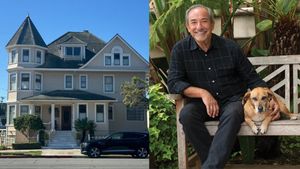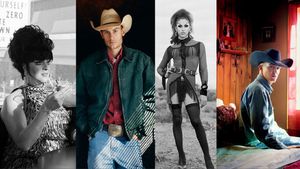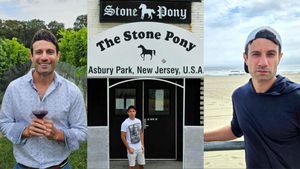
Photo courtesy of Sony Pictures Classics | 'Ira and Viva' painting by Boris Torres
A fleeting shot of a tattoo speaks volumes in Love Is Strange, and it's an image that, according to director Ira Sachs, often leaves viewers "thrown." The tattoo is seen on the arm of a showering Elliot (Darren E. Burrows), whose aging uncle Ben (John Lithgow) is one-half of the gay couple at the film's center (the other half, George, is played by Alfred Molina). Ostensibly, Elliot is your standard upright workaholic -- a man who struggles to break away from his cell phone, even at dinner, and whose stay-at-home writer wife, Kate (Marisa Tomei), seems to know more about their teenaged son, Joey (Charlie Tahan), than Elliot ever will.
Of the many diverse characters in this uniquely nuanced drama, Elliot is one whom audiences may think they have pegged, which is why the reveal of his inked-up shoulder delivers such impact. Suddenly, this stern, if liberal, working man, this head of a New York family and household, flashes a stamp of implied rebellion and past adventures -- things no one would know unless they bothered to ask and learn.
"That tattoo was unexpected," Sachs says. "I asked Elliot to take his shirt off, so I knew it was there, but it wasn't what I was after. There's a Jean Renoir quote that's been important to me as a filmmaker -- and I've never been able to find it, but I still believe he said it -- 'When you're shooting on a set, open the windows and let the world in.' I try to position myself there."
Of course, Sachs is largely referencing the embrace of happenstance, but those open windows, and by extension Sachs's open mind, are what help make Love Is Strange a post-gay landmark in cinema. Ben and George may be the lead characters, and their modest wedding may be the introductory event that binds the subsequent plot threads, but Sachs, along with his cowriter, Mauricio Zacharias (who also shared scripting duties on Sachs's Keep the Lights On), present a work that's universally empathetic and keen to understand all people -- something more progressive and pro-equality by default than by design. Whether objectively exploring the subtle, unwitting homophobia of Kate, or even challenging the audience to decipher the true nature of Joey's relationship with a close male friend, the film leads with the healthy notion that no one should ever presume to fully know anyone else.
The first time I saw Love Is Strange, and the first time I spoke to Sachs about it, was at this year's Berlin Film Festival, the movie's second major stop after its Sundance premiere, and an event that's welcomed Sachs for three of his prior films, including Keep the Lights On. It was on the eve of the Sochi Olympics, and there was no mistaking a certain indoor/outdoor juxtaposition. Not far from Potsdamer Platz, the festival's epicenter, LGBT activists were gathered beneath the Brandenburg Gate, rainbow flags in hand, preparing to protest in front of the Russian Embassy. Shortly thereafter, inside a dark, quiet theater, festivalgoers were held rapt by Love Is Strange, a movie that with its very title conveys that all love is twisty and enigmatic, not just "queer" love. The dual activities comprised a snapshot of opposite ways to subvert oppression: You can command visibility and justice in the streets, or you can accomplish both by allowing queerness to permeate a dramatic narrative with near-complete normalcy.
 Invariably, Sachs is asked in Q&As if he finds it difficult to avoid depicting gay stereotypes in his films. His typical answer relates to the basic philosophy he imparts to students at NYU, where he teaches film in the graduate department: "The only thing you've got is what you know." What and who Sachs knows aren't stereotypes, but people, and his absorption and repurposing of their humanity is his greatest strength as a storyteller (when we meet at his Berlin hotel, he says the only other job he thinks he could have had was as a psychoanalyst). "I don't want to patronize or condescend to my audience," Sachs says, "so I assume my audience is interested in complex representation. With gay people specifically, as individuals, we know we aren't uniquely defined by our sexuality. We often are by others, but not by ourselves."
Invariably, Sachs is asked in Q&As if he finds it difficult to avoid depicting gay stereotypes in his films. His typical answer relates to the basic philosophy he imparts to students at NYU, where he teaches film in the graduate department: "The only thing you've got is what you know." What and who Sachs knows aren't stereotypes, but people, and his absorption and repurposing of their humanity is his greatest strength as a storyteller (when we meet at his Berlin hotel, he says the only other job he thinks he could have had was as a psychoanalyst). "I don't want to patronize or condescend to my audience," Sachs says, "so I assume my audience is interested in complex representation. With gay people specifically, as individuals, we know we aren't uniquely defined by our sexuality. We often are by others, but not by ourselves."
The key conflict in Love Is Strange does stem from an act of gay-targeted bigotry. George has worked as a music teacher at a Catholic school for decades, never hiding his sexual orientation, but when the New York archdiocese learns of his legal marriage to Ben, he's promptly terminated. (What immediately follows might best exhibit Sachs's unyielding patience for human frailty: When George's longtime colleague, the priest who fires him, offers joint prayer as consolation, the devout George resists a wrathful response and says he'll pray on his own; when George mails a letter to his students' parents, his top concern is that his dismissal won't discourage the kids from being themselves). With their income dramatically cut, George and Ben are forced to sell their apartment and live apart -- in the limited spaces of friends and relatives -- for the first time in 39 years. From there on out, the hardships they face have practically nothing to do with their gayness, but rather are the sort of financial dilemmas endured by nearly everyone.
"All of our lives, particularly the drama of our lives, tend to be deeply affected by money and class," Sachs says. "I think all of my films have been aware of that. It's where drama comes from. In psychoanalysis, they say the only thing harder to talk about than sex is money, which sort of tells you its place."
I caught up with Sachs again in New York when Love Is Strange played the Tribeca Film Festival and had its reception at the West Village's famed Julius' tavern, where the movie's penultimate scene takes place (the director was greeting guests near the entrance, the door held open, the world let in). Sachs told me that much of the impetus for Love Is Strange involved his observations that someone like him, now more than ever, "can have a romantic life in New York," a fact reflected by his marriage to artist Boris Torres (with whom he has two children) and bolstered by a newfound, or perhaps renewed, liking of himself. "That's key," Sachs says. "That's something you see in Ben and George. They know themselves individually and as a couple."
But what's most likely to ensure Love Is Strange's canonical endurance, well beyond festival buzz in the United States and abroad, is its hopeful assessment of generational wisdom and understanding. The character of Ben is based on Ted Rust, the partner of Sachs's great-uncle, who remained a practicing sculptor until the age of 98, a year before his death. Rust, Sachs says, was someone he got to know in his mid-twenties and helped him "figure out what a life as an artist would look like." In the film, Ben, through his painting and his affection for George, effortlessly passes on to Joey, his impressionable yet initially resistant grandnephew, a grasp of devotion that's virtually blind to stigma and orientation. Ben's most pivotal painting is, like many artworks that appear in Sachs's movies, a Torres original. Upon its revelation, a swirl of feelings is evoked about the director himself, an art maker who's been exposed to art from so many angles. It's a curious bit of irony: The film ultimately invites the presumption that it's deconstructing, encapsulating, and exhibiting who Sachs is, and yet, its impartial study of people advises that we all be wary of the summing-up of others.
"Philo of Alexandria said, 'Be kind, for everyone you meet is fighting a great battle,' " Sachs says. "As a director, those words are also key to me, even more than in life. Like an analyst, I think a director needs to create a certain distance, to see people as characters with psychology, while at the same time having an empathy for the human condition."
Love is Strange opens in select theaters August 22.



































 Invariably, Sachs is asked in Q&As if he finds it difficult to avoid depicting gay stereotypes in his films. His typical answer relates to the basic philosophy he imparts to students at NYU, where he teaches film in the graduate department: "The only thing you've got is what you know." What and who Sachs knows aren't stereotypes, but people, and his absorption and repurposing of their humanity is his greatest strength as a storyteller (when we meet at his Berlin hotel, he says the only other job he thinks he could have had was as a psychoanalyst). "I don't want to patronize or condescend to my audience," Sachs says, "so I assume my audience is interested in complex representation. With gay people specifically, as individuals, we know we aren't uniquely defined by our sexuality. We often are by others, but not by ourselves."
Invariably, Sachs is asked in Q&As if he finds it difficult to avoid depicting gay stereotypes in his films. His typical answer relates to the basic philosophy he imparts to students at NYU, where he teaches film in the graduate department: "The only thing you've got is what you know." What and who Sachs knows aren't stereotypes, but people, and his absorption and repurposing of their humanity is his greatest strength as a storyteller (when we meet at his Berlin hotel, he says the only other job he thinks he could have had was as a psychoanalyst). "I don't want to patronize or condescend to my audience," Sachs says, "so I assume my audience is interested in complex representation. With gay people specifically, as individuals, we know we aren't uniquely defined by our sexuality. We often are by others, but not by ourselves."






















































